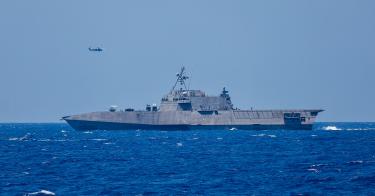America’s inability to produce its own ships at scale has become such a strategic liability that Congress is—finally—acting in a manner not seen since Richard Nixon was President.
But it’s taken a lot of work to get Congress, the executive branch, and industry to a consensus. But after a year-long bipartisan, bicameral effort, a critical point was reached on April 30 when the SHIPS for America Act was introduced.
While policymakers have debated the decline for decades, the numbers now speak for themselves.
In 2022, the People’s Republic of China built nearly 1,800 large oceangoing vessels while the United States built five such civilian vessels. And on the military side, America’s naval shipbuilding sputters years behind schedule and over budget.
>>> Shipbuilding Revitalization Requires Reforms from the Navy, Shipbuilders, and Congress Alike
This collapse in maritime capacity isn’t just a manufacturing failure—it’s a national security risk as well.
American shipbuilding, once a thriving source of blue-collar strength, engine for technological prowess, and geopolitical independence, has been hollowed out by decades of underinvestment, regulatory burdens, and foreign state subsidies.
The Chinese Communist Party, still reeling from the embarrassment of the Third Taiwan Crisis in 1996 and recovering from post-Tiananmen Square massacre sanctions, decided in a 1998 policy paper to seize and dominate global shipping, shipbuilding and ports to defend against future sanctions by controlling the terms of global trade.
That has largely been achieved, while the U.S. and its allies watched. Backed by state subsidies with 53% of all compensated gross tonnage coming from state-owned shipyards, China dominates 49% of the global shipbuilding market. Meanwhile, not a single American port ranks among the world’s 50 best in terms of efficiency.
America is uncompetitive in output, efficiency, and safety. Modernization of American ports is needed to improve worker safety, enhance dockworker benefits via productivity-based bonuses, and attract ever more trade and investments.
The consequences are no longer theoretical. If a conflict broke out in the Pacific tomorrow, the United States would lack the domestic capacity to sustain sealift operations, lay undersea cables, sustain its Navy, or ramp up energy exports to allies. In short, America would struggle to support itself let alone its critical allies in a major war.
The SHIPS for America Act begins to correct this course.
First, it creates a Maritime Security Trust Fund to reconstitute America’s strategic commercial fleet—underwriting the reconstitution of the fuel tankers, military cargo vessels, and undersea cable layers to secure the nation.
While a study commissioned by Congress and executed by the Center for Naval Analysis has yet to be released, recent expert panel groups have estimated the nation needs assured access to over 1,300 ships involved in international trade. To be clear, this is not what is needed to completely replace Chinese shipping or shipping that could be controlled by China; rather, it only mitigates the risk.
Second, the Act proposes a forward-looking financing tool: a trust system that imposes levies on state-subsidized actors and entities of concern, notably China. By imposing inflation-adjusted levies starting at $1.25-$5 per ton on state-subsidized actors and entities of concern, this system finances the Maritime Security Trust Fund.
This trust model aligns perfectly with the principle of strategic reciprocity—those who distort global markets should be targeted for the rebuilding of American capacity.
But the bill as written doesn’t go far enough. To restore the U.S. maritime industrial base, Congress should adopt structural reforms to the tax code and the treatment of shipping investments.
The corporate income tax remains one of the most distortionary elements of U.S. economic policy. It penalizes reinvestment, rewards accounting gimmicks, and contributes to the uncompetitiveness of capital-intensive industries like shipbuilding. Congress could replace the corporate income tax with a Distributed Profits Tax for American port operators, shipbuilders and shippers.
Under this reform, companies would be taxed only when profits are distributed to shareholders, not when reinvested in equipment, yards, or workforce development. This would neutralize the anti-investment bias and reward productive behavior.
Congress should adopt an output capacity-based grant formula system modeled on reforms proposed for the defense industrial base. The principle is simple: the federal government should directly, and only, subsidize the fixed costs associated with maintaining strategic output capacity. A shipyard that can produce four vessels a year but receives only two orders should receive a grant equal to the fixed cost of sustaining the additional capacity.
As civilian orders rise, the grant shrinks. As orders fall, the grant grows. This makes fiscal sense and industrial sense—capacity is funded without wasting resources on unneeded inventory.
Crucially, these grants must be performance-based. If a shipbuilder fails to deliver on time or meet production benchmarks, it should lose eligibility for the next round of funding. This ensures that the system rewards infrastructure and workforce investment for efficiency with good faith, not excuses. The goal must be a surge-ready shipbuilding sector with the capacity to sustain a wartime economy and military.
>>> U.S., Navy Must Do More To Address China’s Growing Maritime Threat
With this in mind, several provisions in the current legislation should be reconsidered. Section 701 gives a 40% tax credit per ship that perversely incentivizes cost inflation. Section 420 creates an arbitrary mandate for American-made hydrocarbon tankers and risks throttling LNG exports to Europe during an energy crisis. Section 433 forces foreign insurers to pay insurance costs 5 times the cargo amount, effectively driving traffic from U.S. ports to Canada and Mexico.
These measures undercut the very competitiveness the bill seeks to restore and should be stripped.
Missing from the December version of this Act, but now incorporated, is a focus on innovation. Section 521 creates innovation incubators while Section 703 creates maritime prosperity zones critical to making the nation’s critical maritime industrial capacity competitive in the global marketplace.
This is where the types of ships needed to ensure the nation’s economy and military will be designed, built, and operated. A new American comparative advantage, as done before with modular shipbuilding and container shipping, will be critical for a sustainable and enduring national maritime effort.
Rebuilding American shipbuilding is not about replicating Chinese volume or competing for every order on the globe. It is about achieving sufficiency guided by principles of efficiency, competitiveness, and readiness: Ensuring that in a time of crisis, the United States has the capacity to supply itself and support its allies.
The SHIPS for America Act is a promising step. But unless Congress adds structural tax reform, a grant-backed capacity model, and rethinks protectionist liabilities, the legislation will struggle to deliver the maritime resurgence America urgently needs.
This piece originally appeared in The Washington Times





